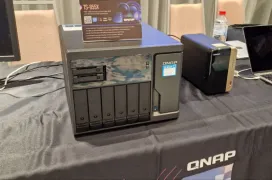Editoriales de Seguridad Informática
Reviews - Guías - Editoriales
5 30/05/2023
QNAP nos muestra sus soluciones software y hardware, potenciadas mediante IA, en el COMPUTEX 2023
QNAP ha comenzado este COMPUTEX 2023 ofreciendo una conferencia acerca de sus productos. QNAP no solo es especialista en dispositivos de almacenamiento en red, también conocidos como NAS, sino que también ofrece un amplio catálogo de tarjetas de red y accesorios para conectividad de hasta 200
15 02/11/2022
¡GEEKNETIC CUMPLE 20 AÑOS! 2 DÉCADAS DE NOVEDADES EN TECNOLOGÍA
Hoy 2 de noviembre de 2022 se cumplen 20 años desde que nació este sitio web. El nombre en sus inicios era HispaZone, pero lo rebautizamos como GEEKNETIC hace exactamente 6 años. En estas dos décadas hemos visto de todo en tecnología, el nacimiento de Facebook y YouTube, el resurgimiento de
1




